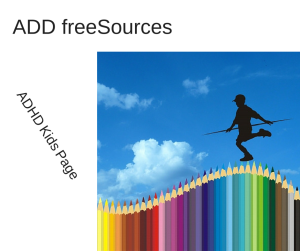Most people have only a vague understanding of what ADHD means. Current DSMV diagnosis standards assume that a lack of attention, distractibility, and hyperactivity are the basic symptoms of ADHD and assign impairment based primarily on those issues.
This avenue of diagnosing ADHD fails to recognize that ADHD is not a deficit of attention, but rather an inability to regulate that attention, an inability to self-regulate, to focus mind and body movement according to the importance of the task. According to William Dodson, M.D, for a child or adult with ADHD, movement toward a future goal is instead “turned on” by an interest-driven brain.
 NO amount of remediation is enough to control all the negative effects of ADHD. Instead, we must each define and use our interests, values, and strengths to find that “zone” where we can do our best work. When we can define the “Why” in a project, we are inspired and empowered to meet our own goals. There’s been some speculation that the symptoms of ADHD, themselves, convey certain strengths. Although I am also inspired by such memes as Awesome Qualities of ADHD from Laurie Dupar, I’ve challenged this viewpoint before in Self-Advocacy for ADHD: Know Yourself.
NO amount of remediation is enough to control all the negative effects of ADHD. Instead, we must each define and use our interests, values, and strengths to find that “zone” where we can do our best work. When we can define the “Why” in a project, we are inspired and empowered to meet our own goals. There’s been some speculation that the symptoms of ADHD, themselves, convey certain strengths. Although I am also inspired by such memes as Awesome Qualities of ADHD from Laurie Dupar, I’ve challenged this viewpoint before in Self-Advocacy for ADHD: Know Yourself.
“In 2015, the VIA Institute on Character, in conjunction with the ADD Coach Academy, conducted a research study to identify whether there are indeed specific strengths of people who have been diagnosed with ADHD. (1) Instead, but not surprisingly, the study found that most people with ADHD had shared difficulties in areas related to impulsivity and sustaining attention. Their weakest ”Strengths” were Prudence, Self-regulation [self-control] and Perseverance. Although the qualities of Creativity, Humor, Kindness, and Teamwork did rank slightly higher in people with ADHD, their highest “Character Strengths” were uniquely individual. (2)
What was a revelation, however, was that when individuals worked in accordance with their highest values, their weaknesses proved to be situational. That is, they were far less of a factor in getting things done when interest inspired action. As David Giwerc explains, “When you focus on what ignites your heart and your positive energy, you will always be able to self-regulate.”
We’re lucky to have two articles from LuAnn Pierce, LCSW that explain just a few of the intricacies of diagnosing and treating ADHD.
The first is Adult ADHD: Soft Signs and Related Issues. Don’t be surprised if you didn’t know about these additional signs to look for. Many clinicians lack the knowledge as well due to inadequate training in school or lack of interest in getting additional training later
- Hypersensitivity/ Sensory Overload
- Overwhelm or Over-stimulation
- OCD-like Coping Skills
- Hyperfocus
- Rejection Sensitive Dysphoria – Overwhelmed and emotionally devastated by any perceived or real criticism or rejection
LuAnn Pierce also covers a lot of territory in ADHD Success at College and Work. She is in good company when she writes that “ADHD is NOT just for Kids – at a minimum, 50-65% of us continue to have symptoms into adulthood. The symptoms may be to a lesser degree or change a bit, but they are ever-present…”
 “Perhaps the most confusing thing about ADHD is that it occurs in some situations but not others.”
“Perhaps the most confusing thing about ADHD is that it occurs in some situations but not others.”
The key is creating an environment that allows you to do what you love best and accommodate for those areas where you struggle. There is no cure for ADHD, but there are ways to deal with the worst of its effects. Diet and exercise, creating habits and building routines as well as more specific ideas for college and workplace concerns can help you be to be effective, productive and successful at work:
Creating that space where you can recharge and help your symptoms fade away is the key to managing ADHD. Accepting your unique strengths and challenges is a work in progress for all of us, but there is a lot of good advice in LuAnn’s article. She finishes with these self-help basics:
- Do not over-schedule – leave extra time between all tasks and leave 15 minutes early for work, etc.
- Work with your symptoms – find a job that fits your skills and create a schedule that fits your sleep patterns.
- Stop trying to be perfect – recognize limits and own your mistakes.
- Make it okay to be different – celebrate your differences and help others understand your needs and strengths.
More resources:
 If the kids get bored this summer, the ADHD Kids Page has lots of things to do, watch and read.
If the kids get bored this summer, the ADHD Kids Page has lots of things to do, watch and read.
To prepare for back to school next month, see:
- Time Management – It’s a Family Affair!– Part 1 of a 3 part article by Coach Cindy Goldrich “Valuable Systems are the Keys to Good Time Management”
- as well as
- Encouraging Self-Advocacy in Teens– by Joan Jager
- 8 Tips to Help you be your Child’s Advocate by Mary Fowler and
- 7 Questions to Help Parents and Children with ADHD Succeed with Homework by Sarah Jane Keyser
VIDEOS:
Appropriate for both children and adults:
Dare to Dream with disability advocate and poet Lederick Horne, this year’s keynote speaker for the Annual ADHD Conference in November. (2 1/2- minutes)
The Learning Brain (7-minutes) “The brain is the sources of all learning. It is where all your thinking, all of your thinking, remembering and feelings resides”
Once again, the newsletter covers a lot of territory and plenty to think about, but there’s a lot to be positive about as well.
Take care,
Joan Jager
Visit us on Facebook or Pinterest!
Photo credits:
Title page created on Canva.com
“ADHD Symptoms Diminish when…” was created on Canva.com
The Awesome Qualities of ADHD from Laurie Dupar –https://www.coachingforadhd.com/awesome-adhd/
Kids page “Image courtesy of vlado/FreeDigitalPhot.net” Modified on Canva.com
Resources
(1) Character Strengths Classification http://www.viacharacter.org/www/Character-Strengths/VIA-Classification
(2) Podcast from the 2015 ADHD Awareness Expo – The Best Things about Adults with ADHD with David Giwerc


